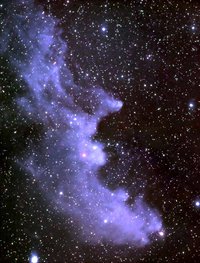Reflection nebula
|
|
In astronomy, reflection nebulae are clouds of dust which are simply reflecting the light of a nearby star or stars. The nearby star or stars are not hot enough to cause ionization in the gas of the nebula like in emission nebulae but are bright enough to give sufficient scattering to make the dust visible. Thus, the frequency spectrum shown by reflection nebulae is similar to that of the illuminating stars. Among the microscopic particles responsible for the scattering are carbon compounds (e. g. diamond dust) and compounds of other elements, in particular iron and nickel. The latter two are often aligned with the galactic magnetic field and cause the scattered light to be slightly polarized (Kaler, 1998). The distinction between these two types of nebulae was done by Hubble in 1922.

They are usually blue because the scattering is more efficient for blue light than red (this is the same scattering process that gives us blue skies and red sunsets).
Reflection nebulae and emission nebulae are often seen together and are sometimes both referred to as diffuse nebulae, an example of this is the Orion Nebula.
Some 500 reflection nebulae are known. Among the nicest of the reflection nebulae are those surrounding the stars of the Pleiades. A blue reflection nebula can also be seen in the same area of the sky as the Trifid Nebula. The giant star Antares, which is very red (spectral class M1), is surrounded by a large red reflection nebula.
Reflection nebulae are also usually sites of star formation.
In 1922, Edwin Hubble published the result of his investigations on bright nebulae. One part of this work is the Hubble luminosity law for reflection nebulae which make a relationship between the angular size (R) of the nebula and the apparent magnitude (m) of the associated star:
- 5 log(R) = -m + k
where k is a constant that depends on the sensitivity of the measurement.
References
- James B. Kaler (1998). Kosmische Wolken. Materie-Kreisläufe in der Milchstraße. Spektrum Akademischer Verlag.de:Reflexionsnebel
fr:Nébuleuse par réflexion it:Nebulosa a riflessione fi:Heijastussumu
